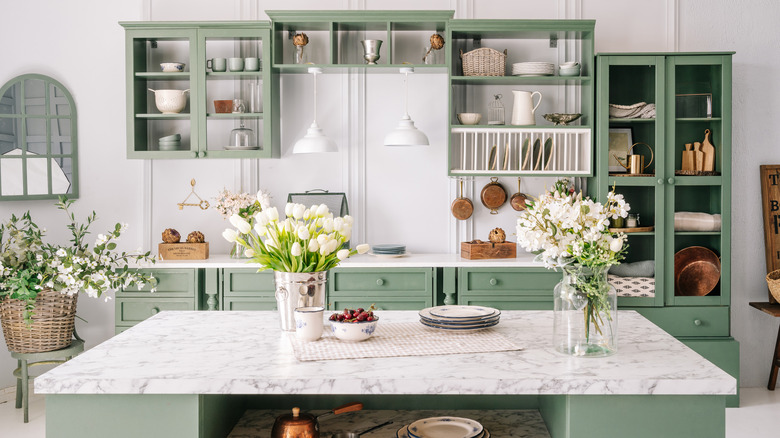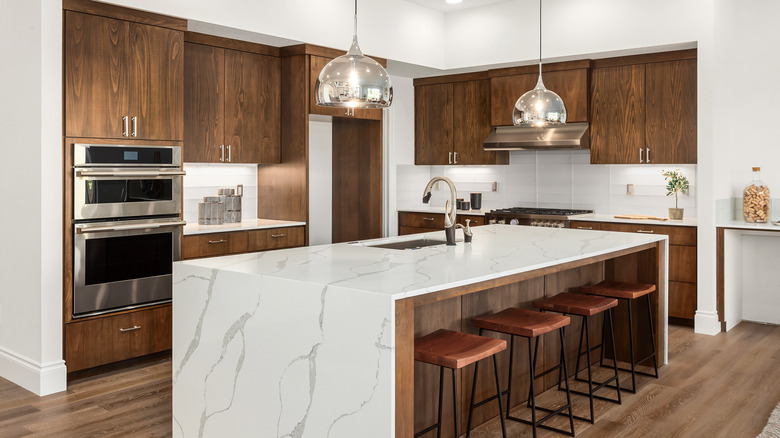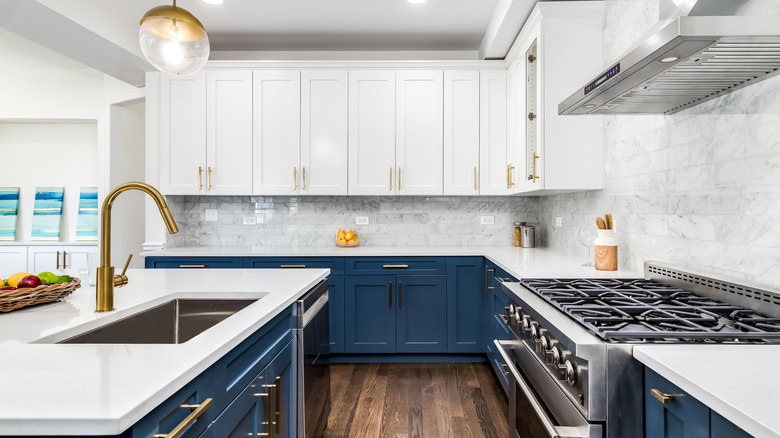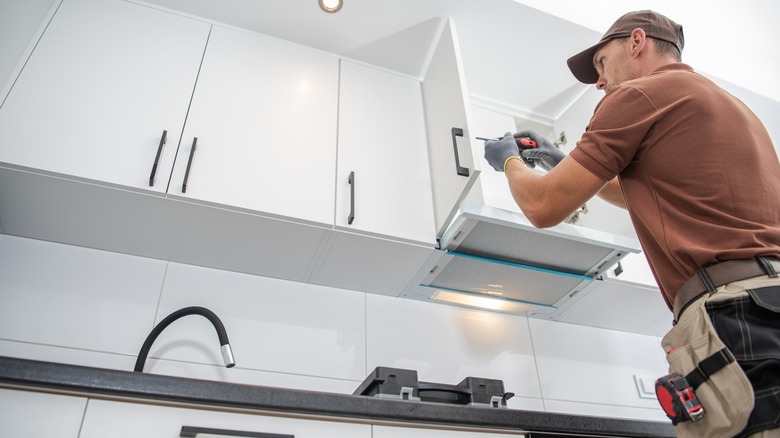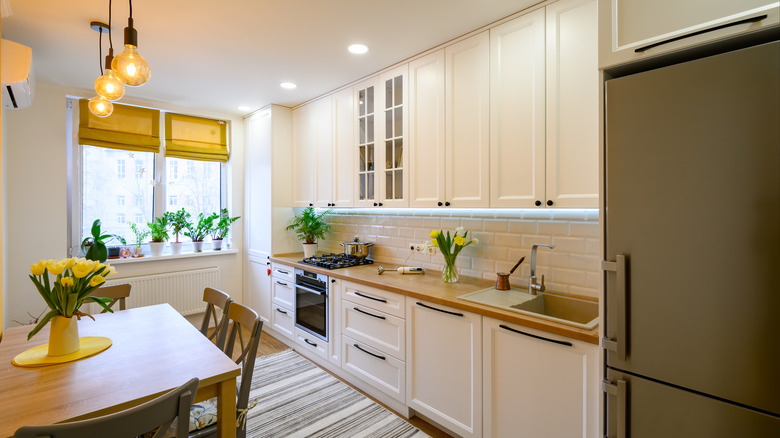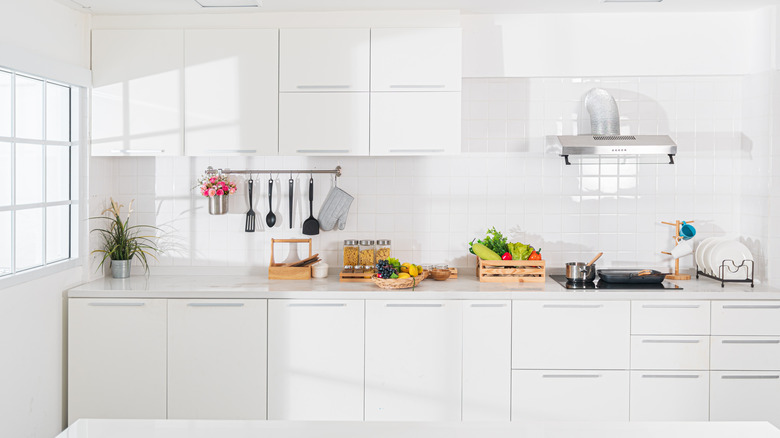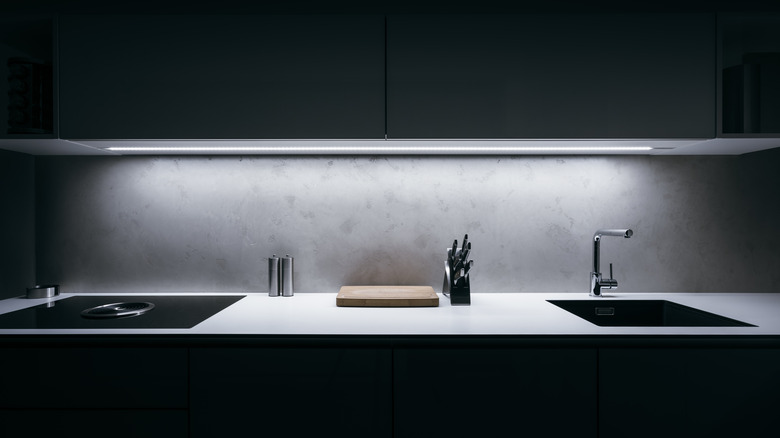How Much Does It Cost To Build Kitchen Cabinets
Building new kitchen cabinets that reflect the personalized needs of you and your family is a dream of many homeowners. Cabinets offer the blueprint of organization in the kitchen, and a poorly designed set of kitchen cabinets can negatively affect the use and flow of your cooking space in a meaningful way. One problem that many homeowners face is in the corners and crannies of their kitchens. Basic installations often work to squeeze in cabinet doors to make use of the space, even as the openings fail to support true utility in these tight areas of the room.
HomeLight reports that cabinet installation (including the price of the cabinets themselves) costs between $100 and $1,200 per linear foot, depending on many different factors that influence the overall price. As well, HomeLight notes that the average for kitchen cabinet installation is about $13,000, with a range from as little as $2,000 to around $24,000.
Remodeling Calculator notes that high-end custom cabinets clock in at the higher end of this range (between $550 and $1,300 per linear foot) while prefabricated, stock cabinets will cost around $60 to $220 per linear foot. Whatever you choose to spend on the cabinet installation, Remodeling Calculator puts a typical, healthy purchase at around 20% to 30% of the total kitchen remodeling budget (when pairing new cabinet installation with other renovations in the space, of course).
Factors for cost
Evaluating your current kitchen can help you gain a better sense of perspective when thinking about a new cabinet installation. As with any renovation, the primary features that influence cost are labor charges and the materials used to create the cabinets. This, however, is not inclusive of the entire scope when understanding how much new cabinets will ultimately run you.
Construction material
The material used to fabricate your new cabinets will play the largest role in dictating the price of the installation. Customized builds will elevate the price tag, with specialized hardwoods and detailed cabinet doors that fit perfectly into your kitchen's unique layout and space costing a premium (as much as $75,000 for a fully luxurious installation that pulls out all the stops, according to Remodeling Calculator).
The materials you select for the build can range dramatically in price, and, therefore, the construction material is perhaps the most important decision you have to make. Many homeowners select MDF or plywood options for their cabinet build because these materials provide a robust structure without raising the price of the installation to an astronomical level.
Labor costs
Labor is the other primary feature when estimating the cost of a cabinet installation. HomeLight reports that labor costs come out to about $50 to $250 per linear foot, depending on geographical considerations, the difficulty of the installation, and other facets of the job.
Labor costs can be mitigated with a DIY installation, but this should really only be tackled by homeowners with a significant confidence level in the home improvement arena. Cabinets tie directly into the functionality and structural soundness of your kitchen more broadly, so a poorly installed set of cabinets can detrimentally affect the utility, aesthetic, and financial value of your kitchen and home.
When you pay for installation, you're really paying for expertise, so choosing wisely when selecting a contractor is crucial.
Project scope
The scope of your home improvements also plays a prominent role in the pricing. The size of your kitchen and ambitions when it comes to the aesthetic and functional changes you're looking to make can feature heavily in the decisions you make in regard to your cabinet installation. A smaller kitchen is going to cost less overall to refinish, making higher-end materials something that even a homeowner with a smaller renovation budget can seriously consider.
Likewise, a large kitchen will cost more to update than a small one, regardless of the quality of the new cabinets, simply because the job is magnified alongside the floor space of the room.
Additional costs
In addition to the standard cost features, you shouldn't forget about a few supplementary facets of the installation process that can influence the final tally.
Tear out the existing cabinets
Along with the installation costs, you'll need to remove and haul away the old cabinets (or break down the cabinet boxes for alternative use). Tearing out existing cabinets can be somewhat time-consuming, and Remodeling Expense reports that this can cost between $150 and $837.50 in most instances.
Removing the existing cabinets allows you the space that's required to install the new units, obviously, but included in this process is a lot of additional clean-up work that is crucial to lay the foundations for a successful renovation. Clearing away the old amenities in your kitchen gives you room to visualize all the potential that's held within your kitchen. If you have the time (for instance, in a fixer-upper), removing old cabinets as early in the process as possible can be a great help in finding inspiration for a total overhaul in the kitchen.
Specializations and customization
Many homeowners want to bring in cabinet specializations and custom installations to their homes. A special order or custom-built addition to the corner spaces or areas surrounding appliances can make all the difference in the utility of your kitchen. Pinterest is full of great customization options, and one or more of these (and other specialty pieces that your carpenter might suggest) might be the perfect inclusion in your home.
Of course, when you bring in specialty builds to the project, this can raise the price of the installation as a result of added fabrication requirements.
Considering the DIY option
Building and installing cabinets yourself can help save you a good deal of money. The elimination of labor charges alone can really add up; however, the commitment is significant when building your own cabinet setup. Homeowners thinking of engaging in this process should be prepared for a long road ahead.
DIY installation isn't difficult in terms of specialized skill (in the same way that building the cabinet shells from scratch will be), according to Real Homes. Installing your cabinets without the help of a professional contractor can provide quality savings on the project, but it's advised to take your time with the project. Removing old units can be time-consuming, and care should be taken to ensure that heavy wood frames don't damage your tiles or countertops in the process.
Once the space is cleared out, you'll want to clean the room thoroughly to remove debris for a seamless installation of the new units. Following a cabinet installation guide and tackling the whole thing in phases will give you the makings of success alongside a great budget additive that will allow you to focus your financial attention on getting the best cabinet construction available or the ability to outfit a large kitchen with good quality materials on a tight budget.
Cabinet types
There are three primary cabinet types that homeowners can select from when changing their kitchen's DNA. These are prefabricated or stock cabinets, semi-custom cabinets, and fully customized cabinet options.
Custom hardwood and natural wood cabinets
Custom cabinets are the top of the line in any kitchen renovation plan. HomeLight notes that natural wood favorites are maple, cherry, oak, pine, and birch. These make for some of the most beautiful kitchen cabinets that money can buy, and with natural wood fabrication, you can expect a long lifespan and excellent visual appeal.
As well, natural wood cabinets are by default a custom creation, meaning that any cabinets that are installed in your home will be crafted specifically to match your kitchen's layout and space-saving needs. There won't be any cutting down sections to fit into tight corners because the whole layout will be designed and built to form a flawless and seamless storage unit across the whole space of your kitchen.
For this unique pleasure, you can expect to pay a serious premium though. HomeLight estimates that these high-end cabinet installation jobs will typically cost between $5,000 and $25,000 to outfit the average kitchen.
Plywood cabinetry
If quality is important but your budget can't allow for the markup of solid wood construction, plywood cabinets are a great choice. Plywood is often used in high-end cabinets (via Remodeling Calculator) and lends itself fantastically well to use in all varieties of cabinetry (custom, semi-custom, and prefabricated options). The semi-custom versatility of plywood cabinets gives homeowners the ability to make intelligent selections of prefabricated shells with their contractor that will fit into the home with ease. Adding custom shelving and doors also provides a touch of personality that a completely prefabricated model can't provide.
Plywood is light and durable, making for an excellent building option for cabinets that range across all levels of customization and price.
Budget options
Prefabricated, or stock cabinets, are great for those looking to make a splash in the kitchen without breaking the bank (via Bob Vila). Stock cabinets are exactly what they sound like: These are cabinet boxes prebuilt to typical kitchen dimensions and existing in a variety of layouts. Stock cabinets are typically built with MDF boards or even plywood, and make for a great addition to the kitchen if your space doesn't require much in the way of customization. Many kitchens are built with simplicity in mind and a prefabricated shell can offer the best in budget consideration while slotting in perfectly to your space.
It's also a good idea to consider sizing and storage layout options that are available in prefabricated cabinets, even if you've already decided to use a customized or semi-custom option. These are built in line with trending design elements, so they can act as a solid guide if you're unsure of where to begin when designing the storage solutions that your cabinets will provide.
Why you need new kitchen cabinets
Installing new kitchen cabinets can transform the look and feel of your kitchen. Home renovations often seek to incorporate big, statement-making alterations and there aren't many opportunities to create the immense change that you may be looking for beyond the kitchen and its cabinets. New cabinets provide a highly visible lifestyle change that echoes throughout the home.
Water damage can minimize the functionality of your existing cabinets
Cabinet doors can become severely damaged as a result of humidity in the kitchen and direct and prolonged contact with water (via Cabinets Direct USA). Kitchens can become damp easily as there are constant temperature changes going on in the spaces directly adjacent to the sink, windows, and stove, making it incredibly easy to develop mold, mildew, and other moisture-related issues. Cabinets are typically made of wood, which will begin to warp and lose structural stability over time when moisture problems become increasingly severe.
Cabinet styles should change with the rest of the kitchen for the best ambiance
Cabinets Direct USA also notes that cabinets are often one of the longest-lasting pieces of equipment in the kitchen. Alongside stone countertops, a high-quality cabinet can last for many decades without much in the way of structural problems, if well cared for.
But cabinet and other design styles change with the times. Cabinet City notes that other renovations in the kitchen can quickly make your cabinets look dated and out of place. When approaching a remodel that sees a new tile floor or backsplash, tackling cabinet replacement or even resurfacing can make the entire room look vibrant and new. If you're thinking of making changes in the kitchen, it's often the best course of action to tackle the entire room at once for a cohesive stylistic theme rather than a kitchen that appears like a mashup of times and decorative ideas.
Benefits of a kitchen cabinet replacement
Cabinet replacements are fantastic for both monetary and lifestyle reasons. Making this change can bring about many phenomenal benefits in your home.
Functionality upgrades the make a huge difference
Cabinet City reports that one of the most important changes that a new cabinet installation can provide is an ease of access that wasn't available in your previous (or current) cabinet layout. Another important change that new cabinets can create in your home is the convenience of a new design for pull-out drawers, corner cabinet doors, and more. Likewise, many older cabinet designs don't account for easy access into the depths of each cabinet box. New cabinets often make use of internal drawers and sliders that can help you make use of every inch of internal storage space in ways that weren't previously possible without a cutting-edge and customized installation.
Financial addition to the home's value
There is always a financial aspect to any remodeling opportunity. Installing new cabinets is often at the forefront of house flippers' minds because minor or moderate home remodeling tasks provide a better return on investment overall than a whole kitchen redesign (via HomeServe). Kitchen cabinets are a major undertaking, of course, but in relation to the installation of new countertops, appliance replacement, and tiling of the floor, cabinets are on the easier end of the spectrum.
Cabinets provide both functionality and great financial value to the homeowner. Selecting great cabinets can provide fiscal power for many years to come.
